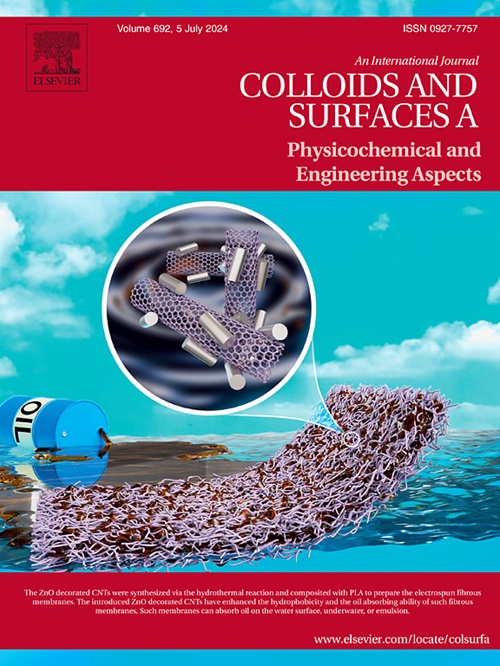Anti-hyperpigmentation polysaccharides from Cinnamomum verum bark: Optimization of extraction, characterization and B16F10 melanoma cell studies
IF 4.9
2区 化学
Q2 CHEMISTRY, PHYSICAL
Colloids and Surfaces A: Physicochemical and Engineering Aspects
Pub Date : 2025-04-10
DOI:10.1016/j.colsurfa.2025.136877
引用次数: 0
Abstract
The skincare benefits of Cinnamomum verum bark polysaccharides were investigated in this study, with special focus on the optimization of deep eutectic solvent (DES)-microwave extraction condition and elucidation of antipigmentation mechanism. Response surface methodology optimization using Box-Behnken design has achieved optimal extraction at 4 % (w/v) DES, 4 min and 360 W microwave power that resulted in (i) 7.00 ± 0.78 % polysaccharide yield; (b) 97.22 ± 0.27 % monophenolase inhibitory activity; (c) 86.81 ± 2.64 % diphenolase inhibitory activity; (d) 60.47 ± 4.23 % of 2,2-diphenyl-1-picrylhydrazyl (DPPH) scavenging power and (e) 5.919 ± 0.60 sun protection factor (SPF). The extracted polysaccharide comprised of 39.18 ± 0.28 % uronic acids, 39.49 ± 4.35 % carbohydrate and < 2 % protein and polyphenolic contents. Monosaccharide composition analysis identified glucose, galactose, ribose and glucuronic acid as the major sugar units, suggesting the possible identity of galactan or glucuronan-type heteropolysaccharide. The 31.3 ± 0.5 kDa polysaccharide exhibited IC50 values of 1.59 and 1.84 mg/mL on monophenolase and diphenolase inhibitory activities, respectively. It employed mixed-mode inhibition mechanism against tyrosinase, based on the Lineweaver-Burk plot and kinetics study (increasing Km and decreasing Vmax values). The capability of the polysaccharide to chelate copper (74.1 % at 5 mg/mL) also suggested an alternate inhibitory mechanism through copper chelation. In addition, the polysaccharide showed optimum intracellular tyrosinase inhibition, certain impact on intracellular melanin level, as well as exhibited effects in intracellular cAMP level and fold changes in genes Mitf, Tyr, Trp-1 and Trp-2 in B16F10 melanoma cells. These findings demonstrate the potential of Cinnamomum verum bark polysaccharides as potential active ingredients for anti-pigmentation, antioxidant, and sun-protective skincare formulations.
求助全文
约1分钟内获得全文
求助全文
来源期刊
CiteScore
8.70
自引率
9.60%
发文量
2421
审稿时长
56 days
期刊介绍:
Colloids and Surfaces A: Physicochemical and Engineering Aspects is an international journal devoted to the science underlying applications of colloids and interfacial phenomena.
The journal aims at publishing high quality research papers featuring new materials or new insights into the role of colloid and interface science in (for example) food, energy, minerals processing, pharmaceuticals or the environment.

 求助内容:
求助内容: 应助结果提醒方式:
应助结果提醒方式:


